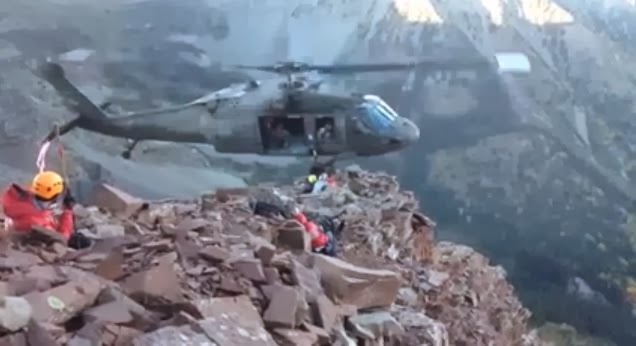A Life Aloft
Well-Known Member
That looks like some serious talent and skills to me as this pilot balances one wheel on the edge of this mountain surface and balances the weight (rescuers inside leaning out to help the man being recused and then the shifting balance of the pax and crew repositioning themselves inside the chopper.
Sept. 23, 2013 A 59-year-old man had to be rescued by helicopter after falling while descending North Maroon Peak on Saturday. The man fell 50 feet while descending 200 feet below the summit of the technical 14,014-foot peak, according to a Pitkin County Sheriff’s Office press release. The climber suffered numerous injuries, including a possible broken jaw. (turns out he had broken his jaw and back and smashed up his face pretty badly but is home now recuperating after spending a week in the hospital) The helicopter rescue was successful and caught on video. The injured climber was with four other people when the accident occurred.
The helicopter took MRA rescuers and the patient to the Aspen airport, where an ambulance transported him to Aspen Valley Hospital. He was later airlifted to Colorado Springs.
The ground team was from the Mountain Rescue Aspen team. MRA is a volunteer organization that serves as an arm of the sheriff’s office, and does not charge the public for its services.
A Flight for Life helicopter out of Summit County dropped MRA members on the mountain. They met the patient and his party and assisted them to a spot where a HAATS (Colorado Army National Guard’s High Altitude Aviation Training Site) Blackhawk helicopter could reach them. “Stories abound of combat rescue in Afghanistan, by military crews that honed their skills back home."

Maybe @MikeD could comment on this technique and how such a maneuver is accomplished. (since my knowledge of chopper flying is sorely lacking/non-existent)
Sept. 23, 2013 A 59-year-old man had to be rescued by helicopter after falling while descending North Maroon Peak on Saturday. The man fell 50 feet while descending 200 feet below the summit of the technical 14,014-foot peak, according to a Pitkin County Sheriff’s Office press release. The climber suffered numerous injuries, including a possible broken jaw. (turns out he had broken his jaw and back and smashed up his face pretty badly but is home now recuperating after spending a week in the hospital) The helicopter rescue was successful and caught on video. The injured climber was with four other people when the accident occurred.
The helicopter took MRA rescuers and the patient to the Aspen airport, where an ambulance transported him to Aspen Valley Hospital. He was later airlifted to Colorado Springs.
The ground team was from the Mountain Rescue Aspen team. MRA is a volunteer organization that serves as an arm of the sheriff’s office, and does not charge the public for its services.
A Flight for Life helicopter out of Summit County dropped MRA members on the mountain. They met the patient and his party and assisted them to a spot where a HAATS (Colorado Army National Guard’s High Altitude Aviation Training Site) Blackhawk helicopter could reach them. “Stories abound of combat rescue in Afghanistan, by military crews that honed their skills back home."
Maybe @MikeD could comment on this technique and how such a maneuver is accomplished. (since my knowledge of chopper flying is sorely lacking/non-existent)
Last edited:
